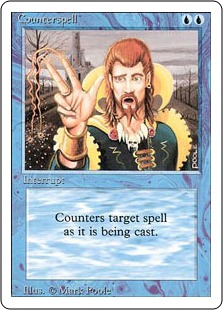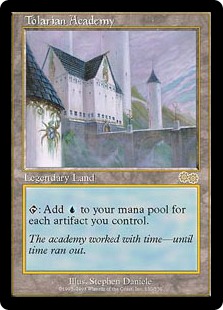
Comments are available here.
A look of utter disgust hits your face. As you recover from the shock, you slouch your head forward, holding it in your hand, wide-eyed. You shake your head from side to side, so appalled at someone having the nerve to even think of that. You're aware you may never be able to come to terms with it, and you decide to click on the link only out of morbid fascination.
That might've happened just now. Or...
Your eyes light up like a kid's on Christmas morning. Almost unwillingly, a grin begins to stretch across your face; one that may be described as "creepy" by someone sitting beside you. You think of how you'll never feel forced into Mono-Red or a green ramp strategy. You'll always have your old friend or something like it somewhere in your deck, as your safeguard against the monsters, countering them as they're being cast. You need to know the specifics, and you click on the link joyously.
I've never seen someone react to the fact that I've made a Mono-Blue Cube in any other way. Only those two options exist. It's a shame that two-thirds of people go for the first one, because what started out as just a curiosity-fuelled experiment has blossomed into an actually extremely fun draft format. There's ramp, midrange, combo, control, aggro... any broad strategy you can find in a regular cube exists here, albeit looking drastically different. There are also a few narrower ones that you could never even dream of drafting normally. It's surprisingly varied, and the only constant is knowing your opponent has something when coloured mana's untapped.
I got the idea and started work on this back in August, when someone came to my local card shop with what he called his "Mono-Brown" cube—a cube that contained almost all artifacts, with many weird and wacky strategies available. After drafting that a couple of times, it got me thinking, instead of excluding all the colours, what if I included only one in a cube? The idea of cubing always intrigued me, but I'm a guy who likes to do things in a unique way, and regular cubing seemed too much of a "solved format" to really make it seem like my own creation. I've also found that many players, including myself, are simply overwhelmed when they open a cube pack, and don't know what to take, what to draft, or really what to do at all. I figured that limiting it to one colour would take away most of that uncertainty, and I chose blue for a few reasons:
- I guessed it was the only colour that had good control, combo and aggro strategies, the first being obvious, the second being decks reminiscent of the one's in Urza's Block, and the third being Merfolk.
- It would probably lead to the most interaction out of all of the colours due to the counterspells.
- "Mono-Blue" just sounds more exciting to people than mono-black, white, or, god forbid, red or green. Marketing and presentation is an important aspect of cubing, because even if your cube is awesome, if no one knows that, it might was well be terrible.
But one last thing before we get into the main part of the article: as many (fairly annoying) nitpickers have pointed out, I can't technically call this a Mono-Blue cube. It also includes artifacts, lands, and a few hybrid cards. What matters, though, is that there is no logical reason to play any non-blue basics. While the name may not be technically correct, I've found that it's catchiness makes up for the occasional complaint. It's certainly better than anything else I could call it.
Because the cube's limit to one colour, some things just don't show up as much as they usually do. Removal in particular is hard to come by, and the removal spells that exist, while overcosted, are actually all decent picks. Psionic Blast in particular can even be a first pick, as it's the only spell that can burn someone out effectively. Artifact removal is also hard to come by and overcosted, forcing me to get creative with the cards I put in (though it is pretty sweet to steal someone's Blightsteel Colossus with a Master Thief off a Show and Tell).
Another facet that's a product of the whole thing being blue is just the sheer number of counterspells that are in it, and how their ubiquitous presence warps the whole format. Cards like Pestermite get miles better because of it, since you'll constantly get games where the first few turns just consist of playing Islands and passing. This can make games a very skill-testing and cerebral affair. Knowing if it's better to cast Conundrum Sphinx now or to hold up Mana Leak for another turn can be the difference between winning and losing. Once something is on the board, it largely stays there.
Now for the archetypes. These are what prevent the cube from just being everyone fighting for everything. Most of these were artificially created, but they're now all pretty much organic, changing from deck to deck with some cards proving themselves to be much better than I expected. Eight distinct archetypes are supported, and I'll go into detail on each one:
Control

Aggro-Control
A slightly more forgiving archetype than pure control. This deck focuses on playing evasive threats that are small, have flash, or both, and eventually winning with them while staying safe behind a curtain of countermagic. I describe this archetype as more forgiving because your creatures give you some answers to smaller on-board threats; additionally, bounce spells are things you actively want to play rather than being forced to, as you value tempo as well as card advantage. Anyone who remembers playing Delver or Faeries fondly will feel very familiar with this strategy.
Merfolk
If you want to draft aggro, this is what you go for if you're shooting high. A Merfolk deck that gets the right density of them can be nigh-unbeatable, especially if backed up by cheap counters and broken cards like the Swords. On the other hand, if they just don't get opened, or if two or more people are forcing it, everyone can just end up with a bad aggro deck--non-evasive Merfolk are fairly lame. But if you like drafting Mono-Red in normal cubes, I think you'll be able to find happiness with this deck. It's got the risk, it's got the reward, and it certainly has the good beats.
Flier Aggro
The less ambitious aggro strategy. Unlike Merfolk, this deck's power level is fairly consistent—a Horizon Drake is an Illusionary Servant is a Sea Drake. Don't go thinking this is an easy strategy to beat, though—if you're unprepared, what just looks like a mere Core Set Skies deck will come flying over and crashing through your skull. These little beasties are ones to be feared and respected, and they've already won over at least one of my regular drafters.
Tinker/Show and Tell/Academy Artifacts

Mill
Blue burn, but better. These decks prey on the natural card-drawing tendencies of many decks in this cube, and can be very powerful if the right cards are opened. There are mill cards like Mind Sculpt that can outrace aggro, and slow, inevitable mill cards like Pyxis of Pandemonium that give control decks fits. A well-drafted and constructed mill deck can be the bane of most any deck at the table, but a poorly-drafted one can crash and burn extremely quickly.
High Tide/Storm
On a rare occassion, this deck gets opened like magic, and someone is gifted with a fun and powerful combo deck that rewards play skill a lot more than a simple Tinker/Show list. Unfortunately, nine times out of ten, the namesake card just gets opened too late, or there are less than eight people at the table and not all the cards needed are opened at all. Trying to draft it is a risky proposition in and of itself, but the rewards can be great. Think of it like normal storm decks in the MTGO Cube. If you consider all of those trainwrecks, you won't much like this deck either; on the other hand, if you're the guy who's always snapping up Tendrils of Agony, I think you'll be very happy to get this deck whenever you can.
Midrange/Ramp
When I first made the Cube, I didn't even consider this to be a viable archetype. "Wouldn't they just counter your big dude?" I thought, as well as said to the people around me. But when it all came together and people other than me started drafting it, the results proved me wrong. To my astonishment, "overloading" their counterspells with threat after threat was actually a good strategy to a downright scary degree. The fact that many of the counterspells in the cube are soft counters makes this deck even more dangerous, as decks playing them are faced with a lose-lose proposition: "Do I counter their ramp spell now, and only delay the inevitable whammy-slam, or do I let it resolve and have my counter become potentially useless?" This question may sometimes be infuriating, but I am still happy to say that if you do like drafting green ramp strategies, then you'll be happy to know that there's a successful analogue here, as well.
Those are the main archetypes, but there are also a few other cards thrown in that can make for less-seen strategies or just simply plan Bs in other decks, cards and combos like:
Painter's Servant + Grindstone and Time Vault + Voltaic Key are the two most potent combos in the entire cube, capable of a win on turn 3 with no other nonland cards. The downside about them is that the pieces are all unplayable without the other half, and that they're both too fragile to support building a whole deck around them. One counterspell shouldn't make you scoop on the spot, and spending precious turns Mystical Tutoring for Fabricate are turns your opponent gets to set himself up for the inevitable plays. However, if you have three or four of the two-card combos listed, it may be worth it to just play something akin to a weird combo-midrange deck, just trying to force through one of them. If they counter the first, search up the second. That strategy is only conjecture, though; I've never seen someone actually try it out.
In conclusion, I've seen most, if not all, of the main archetypes drafted, and a lot of varied builds leading to success by many different pilots. The matches I've played are some of the most skill-rewarding and intensive ones I've ever had, and every time I come away from a draft, I feel more knowledgeable than when it began.
Look forward to part two of this article soon, where I'll recap a recent draft that went down, and go into why some of the decks were successful and others weren't. I'll see you all then.
Comments